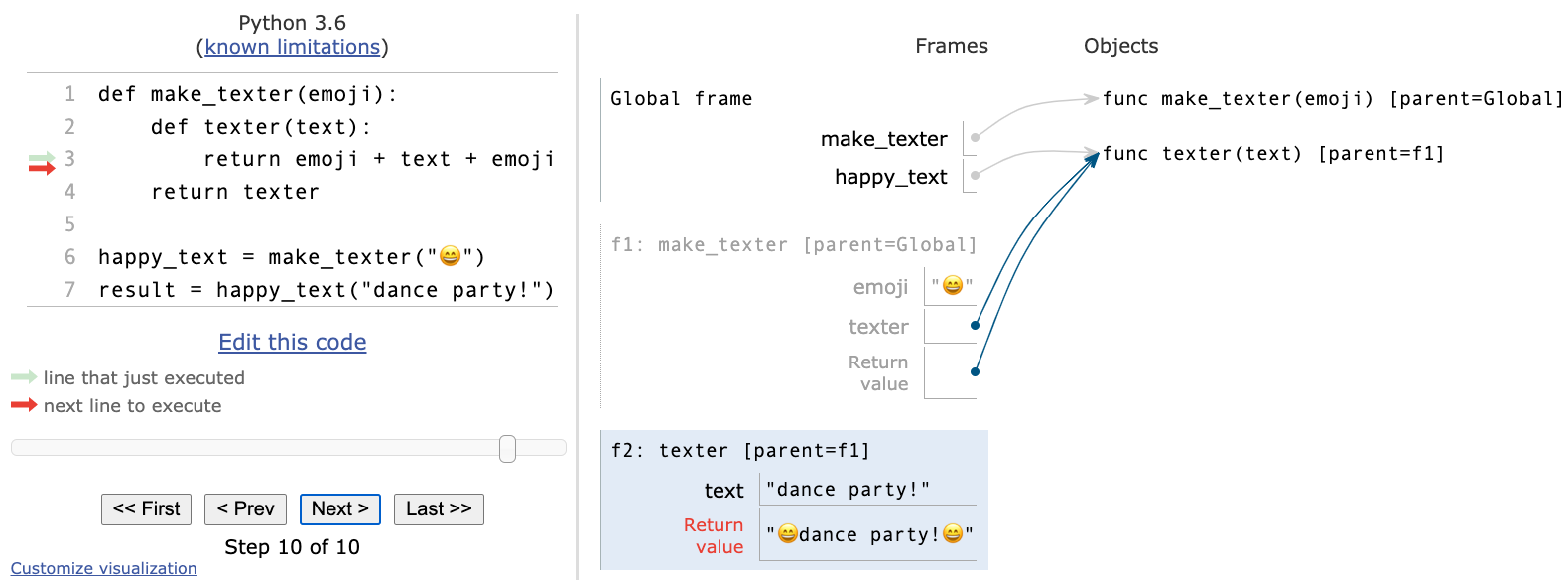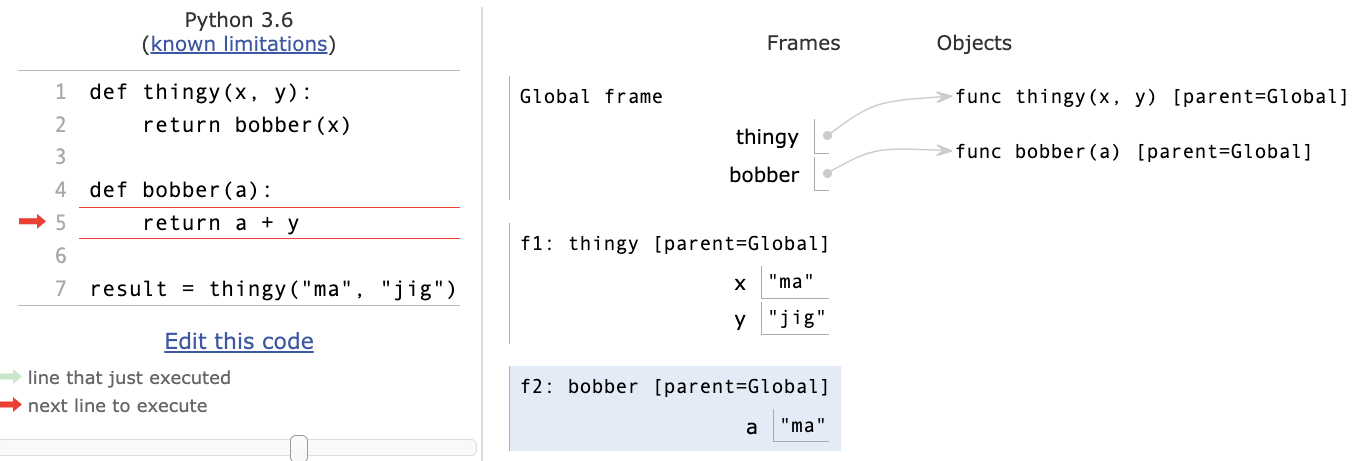Environments
- Press O or Escape for overview mode.
- Visit this link for a nice printable version
- Press the copy icon on the upper right of code blocks to copy the code
Class outline:
- Multiple environments
- Environments for HOFs
- Local names
- Function composition
- Currying
Multiple Environments
Life cycle of a function
| What happens? | ||
|---|---|---|
| Def statement |
|
|
| Call expression |
|
|
| Calling/applying |
4 ▶
def square( x )
▶ 16
|
|
A nested call expression
- next prev prev prev prev prev prev prev next prev next next prev
- next next
- next next next next next next next prev prev prev
def square(x):
return x * x
square(square(3))
| square | ⚫️ | ----> func square(x) [parent=Global] |
| x | 3 | |
| Return value | 9 |
| x | 9 | |
| Return value | 81 |
Multiple environments in one diagram!
def square(x):
return x * x
square(square(3))
| square | ⚫️ | ----> func square(x) [parent=Global] |
| x | 3 | |
| Return value | 9 |
| x | 9 | |
| Return value | 81 |
An environment is a sequence of frames.
- Environment: Global frame
- Environment: Local frame (f1), then global frame
- Environment: Local frame (f2), then global frame
Names have no meanings without environments
def square(x):
return x * x
square(square(3))
| square | ⚫️ | ----> func square(x) [parent=Global] |
| x | 3 | |
| Return value | 9 |
| x | 9 | |
| Return value | 81 |
Every expression is evaluated in the context of an environment.
A name evaluates to the value bound to that name in the earliest frame of the current environment in which that name is found.
Names have different meanings in different environments
def square(square):
return square * square
square(4)
| square | ⚫️ | ----> func square(square) [parent=Global] |
| square | 4 | |
| Return value | 16 |
Every expression is evaluated in the context of an environment.
A name evaluates to the value bound to that name in the earliest frame of the current environment in which that name is found.
Environments for higher-order functions
Review: Higher-order functions
A higher-order function is either...
- A function that takes a function as an argument value
summation(5, lambda x: x**2) - A function that returns a function as a return value
make_adder(3)(1)
Functions are first class: Functions are values in Python.
Example: Apply twice
def apply_twice(f, x):
return f(f(x))
def square(x):
return x ** 2
apply_twice(square, 3)
Arguments bound to functions


Environments for nested definitions
Example: Make texter
def make_texter(emoji):
def texter(text):
return emoji + text + emoji
return texter
happy_text = make_texter("😄")
result = happy_text("lets go to the beach!")
Environments for nested def statements

- Every user-defined function has a parent frame
- The parent of a function is the frame in which it was defined
- Every local frame has a parent frame
- The parent of a frame is the parent of the called function
- An environment is a sequence of frames.
How to draw an environment diagram
When a function is defined:
- Create a function value:
func <name>(<formal parameters>) [parent=<label>] - Its parent is the current frame.
- Bind
<name>to the function value in the current frame
When a function is called:
- Add a local frame, titled with the
<name>of the function being called. - Copy the parent of the function to the local frame:
[parent=>label<] - Bind the
<formal parameters>to the arguments in the local frame. - Execute the body of the function in the environment that starts with the local frame.
Local names
Example: Thingy Bobber
def thingy(x, y):
return bobber(y)
def bobber(a):
return a + y
result = thingy("ma", "jig")
🤔 What do you think will happen?
Local name visibility
Local names are not visible to other (non-nested) functions.

- An environment is a sequence of frames.
- The environment created by calling a top-level function consists of one local frame followed by the global frame.
Function Composition
Example: Composer
def happy(text):
return "☻" + text + "☻"
def sad(text):
return "☹" + text + "☹"
def composer(f, g):
def composed(x):
return f(g(x))
return composed
msg1 = composer(sad, happy)("cs61a!")
msg2 = composer(happy, sad)("eecs16a!")
🤔 What do you think will happen?
Example: Composer (Part 2)
One of the composed functions could itself be an HOF...
def happy(text):
return "☻" + text + "☻"
def sad(text):
return "☹" + text + "☹"
def make_texter(emoji):
def texter(text):
return emoji + text + emoji
return texter
def composer(f, g):
def composed(x):
return f(g(x))
return composed
composer(happy, make_texter("☃︎"))('snow day!')
Composer 2 expression tree
Currying
add vs. make_adder
Compare...
from operator import add
add(2, 3)
def make_adder(n):
return lambda x: n + x
make_adder(2)(3)
🤔 What's the relationship between add(2, 3) and make_adder(2)(3)?
Function currying
Currying: Converting a function that takes multiple arguments into a single-argument higher-order function.
A function that currys any two-argument function:
def curry2(f):
def g(x):
def h(y):
return f(x, y)
return h
return g
make_adder = curry2(add)
make_adder(2)(3)
curry2 = lambda f: lambda x: lambda y: f(x, y)
Why "currying"?
It's not food! ❌ 🥘 ❌ 🍛
Named after American logician Haskell Curry, but actually published first by Russian Moses Schönfinkel, based on principles by German Gottlob Frege.
See also: Stigler's law of eponymy